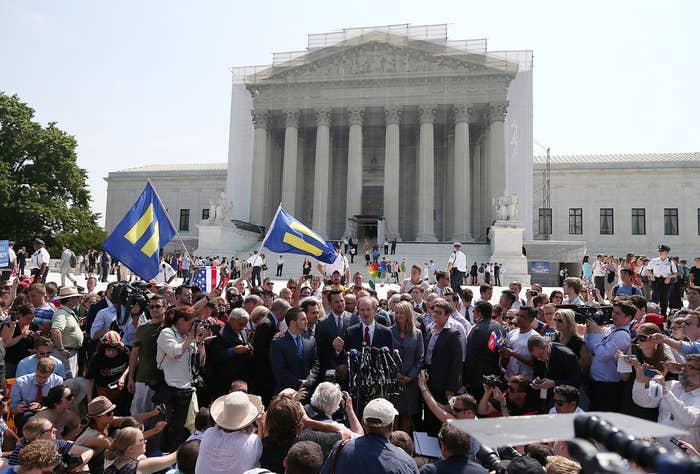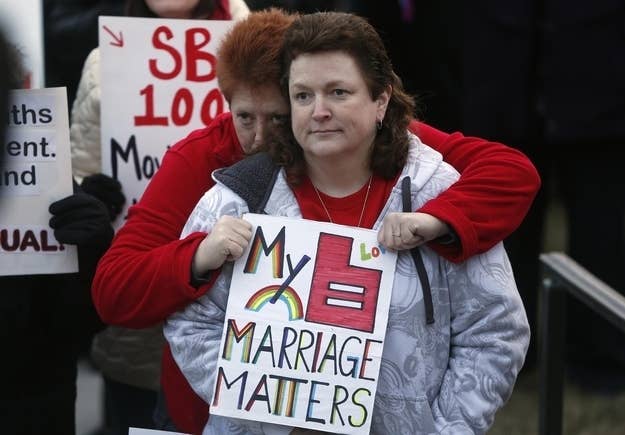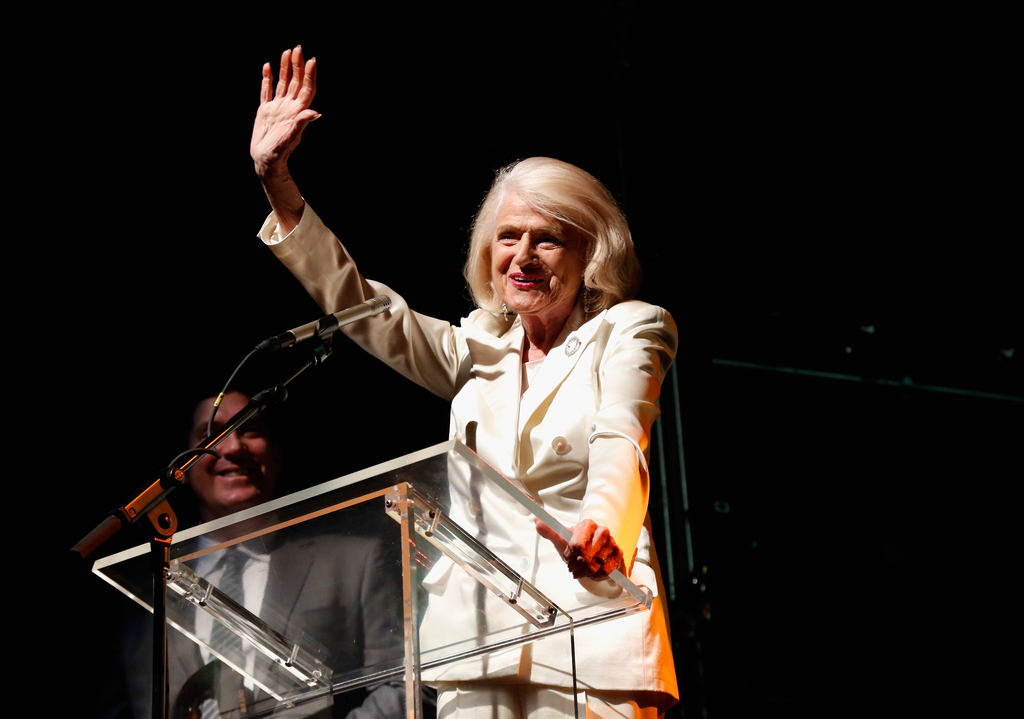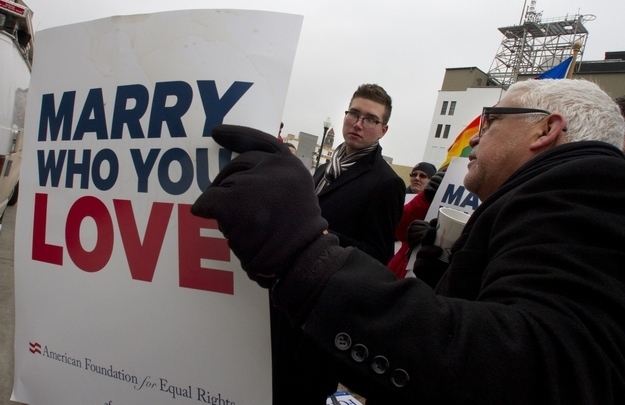
WASHINGTON — Utah, Ohio, Oklahoma, Kentucky, and Virginia.
In the past two months, five federal judges appointed by presidents of both major parties struck down constitutional amendments aimed at limiting same-sex couples' marriage rights. In three states, they found marriage bans unconstitutional; in two others, they ruled that states must recognize marriages performed elsewhere.
"We have arrived upon another moment in history when We the People becomes more inclusive, and our freedom more perfect," U.S. District Court Judge Arenda L. Allen Wright wrote in striking down Virginia's ban on Thursday evening.
This sudden rush follows a single action: Justice Anthony Kennedy spoke.
Before the decisions of these past two months, Judge Vaughn Walker's August 2010 decision striking down California's Proposition 8 marriage amendment was the only such decision to come from a federal judge in the nation's history.
In fact, two other trial court judges — one in Nevada and one in Hawaii — found against same-sex couples suing in those states for a right to marry in 2012.
What happened in the interim was both critical to the change and expected by those who have been watching the law develop in this area over the past two decades — and centers on the language of Kennedy's Supreme Court ruling.
In Edith Windsor's challenge to the Defense of Marriage Act, she fought, successfully, for the Supreme Court to strike down DOMA's ban on the federal government recognizing same-sex couples' marriages.
Kennedy, writing the opinion for the court's five-member majority, said of DOMA that its differential treatment of same-sex couples "demeans the couple, whose moral and sexual choices the Constitution protects ... and whose relationship the State has sought to dignify. And it humiliates tens of thousands of children now being raised by same-sex couples."
Further, he wrote, "Under DOMA, same-sex married couples have their lives burdened, by reason of government decree, in visible and public ways. By its great reach, DOMA touches many aspects of married and family life, from the mundane to the profound."
That opinion has led to dozens of marriage cases being filed across the nation and touched off a unanimous view from lower court federal judges since that same-sex couples have a right to marry and/or have their marriages from other jurisdictions recognized — a point made even more broadly by David Cohen and Dahlia Lithwick at Slate on Friday.

How did we get here?
When Kennedy wrote that the "moral and sexual choices" of same-sex couples are protected, he was referring to and extending the impact of his own opinion for the Supreme Court striking down sodomy laws as unconstitutional in 2003.
That opinion, Lawrence v. Texas, was his second opinion in a "gay rights" case. His first, in 1996, was in a case in which the Supreme Court struck down Colorado's Amendment 2 banning cities and other political subdivisions in the state from banning discrimination against gay, lesbian, or bisexual people.
In that nearly 18-year-old opinion, Kennedy wrote for the court, "Amendment 2 classifies homosexuals not to further a proper legislative end but to make them unequal to everyone else. This Colorado cannot do. A State cannot so deem a class of persons a stranger to its laws."
That was the first time the Supreme Court had spoken out in favor of equal treatment of gay, lesbian, and bisexual people. Kennedy expanded that ruling by striking down sodomy laws in Lawrence, and he left no doubt about the path he is on when he issued the court's opinion in United States v. Windsor this past June.
The court avoided answering the larger question of whether states need to allow same-sex couples to marry, a question that was brought to the court in the Proposition 8 case. The justices, however, tossed out that appeal on technical grounds of standing because none of the government officials responsible for enforcing California law brought the appeal. The move meant the trial court decision striking down California's amendment remained, but it applied only to California.
Additionally, since 1996 and including in Windsor, the Supreme Court has never decided an underlying issue of whether sexual orientation-based laws or government policies should be subjected to the same kind of judicial scrutiny given under Constitution's equal protection clause to laws that classify based on sex or other such attributes.
Such heightened scrutiny would mean that government officials would need to show an important reason for treating gay people differently than straight people — a rule that most experts believe would invalidate all state marriage bans.

What has happened since then?
Despite that ambiguity, federal judges in lower courts have reached their own conclusions. In January, U.S. District Court Judge Terence Kern wrote in striking down Oklahoma's marriage ban, "There is no precise legal label for what has occurred in Supreme Court jurisprudence beginning with Romer in 1996 and culminating in Windsor in 2013, but this Court knows a rhetorical shift when it sees one."
A week later, a three-judge panel of the 9th Circuit Court of Appeals agreed in a case unrelated to marriage but establishing — within the 9th Circuit — that Kennedy had, in the effect of his rulings, resolved the question of scrutiny.
"In its words and its deed, Windsor established a level of scrutiny for classifications based on sexual orientation that is unquestionably higher than rational basis review. In other words, Windsor requires that heightened scrutiny be applied to equal protection claims involving sexual orientation," Judge Stephen Reinhardt wrote for the court.
That decision already led officials in Nevada — the Republican governor and Democratic attorney general — to stop their defense of their state's ban on allowing same-sex couples to marry in the 9th Circuit appeal of that 2012 trial-court loss.
And, with slightly varying rationales, judges in Utah and Virginia also have struck down marriage bans for same-sex couples and judges in Ohio and Kentucky have struck down bans on officials there recognizing same-sex couples' marriages obtained elsewhere.

Where do we go from here?
Following Thursday night's decision in Virginia, assuming it is appealed, marriage rights or marriage recognition cases will be fought out in four of the appellate circuits in the country — the courts of appeals below the Supreme Court.
In the 4th Circuit, the judges would be hearing an appeal of the Virginia decision. In the 6th Circuit, the judges will be hearing appeals of the Ohio and Kentucky decisions. In the 9th Circuit, the judges are hearing the appeal of the Nevada decision. Finally — as of now — judges in the 10th Circuit are due to hear the appeal of the Utah case on April 10 and the appeal of the Oklahoma decision on April 17.
There are cases pending in numerous other states as well though, and decision from those trial-court judges could throw more circuits into the mix.
Because appellate decisions are binding on all the federal judges in any states within a given circuit, these decisions, once they start happening, will make it all the more likely that Kennedy and his fellow justices will be forced to confront the question avoided with the dismissal of the Proposition 8 appeal last June sooner rather than later.
Although the justices get to decide whether they will hear a case — four justices need to choose to hear an appeal — it will be increasingly difficult for the court to turn down appeals that, in effect, give same-sex couples in some parts of the country a constitutional right to marry while leaving other parts of the country without the same rights.
As such, as the courts of appeals hear and decide these cases, requests will start making their way to the Supreme Court — similar to what happened in 2012 with the multiple DOMA challenges — as soon as later this year. If the Supreme Court hears a marriage case in its next term, that would mean a decision would be expected by June 2015.

What could slow things down?
Even in these cases, there are more narrow issues in some of them that might not lead to a so-called "50-state solution" that would mean marriage equality for all 50 states as the result of a win for the plaintiffs at the Supreme Court.
For example, the marriage recognition cases — though closely linked to marriage rights — present the more narrow question of whether marriages from other states must be recognized in states — here, Ohio and Kentucky — that don't allow same-sex couples to marry.
In theory, the court could decide that issue first, putting off a decision on the actual question of whether states must grant same-sex couples marriage licenses for some additional time.
Additionally — and one that is outside of the control of both LGBT advocates and government officials — is what will happen with the 9th Circuit decision regarding heightened scrutiny.
The case raises the question of whether sexual orientation can be used as a basis for excluding a person from a jury and was raised in a patent dispute between SmithKline Beecham and Abbott Laboratories. As such, the decision whether to appeal the decision to the full 9th Circuit or to the Supreme Court rests with Abbott.
If the case is appealed to the Supreme Court, the justices could take that case to resolve the question of the level of scrutiny while holding the marriage cases. It could then, as it did with cases after Lawrence and Windsor, send those other cases back to the appellate courts to reconsider the cases in light of the justices' decision about the level of scrutiny. Then, once those cases are decided, appeals would return to the Supreme Court at which point the court likely would be forced to take the case and decide the issue.
